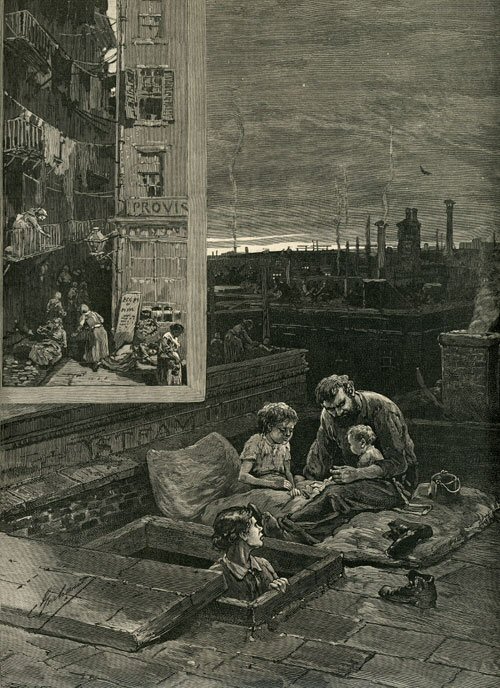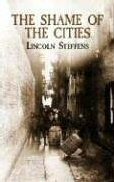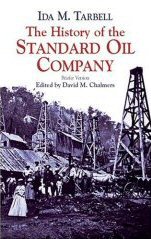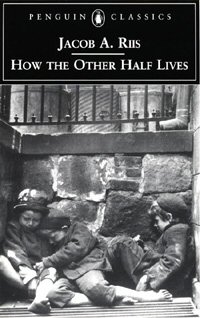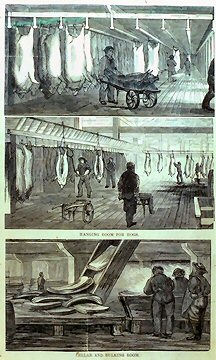Introduction to Research in the Digital Age Research Journal Project One
By Jeffrey T. Zarate Title of Research Project: Immigration, Industrialization and The Jungle by Upton Sinclair
Project Topic - The effects of immigration and industrialization on America between the 1880s and the 1920s based on the the novel The Jungle. Were working conditions described realistically in the book? Search Strategy - I will utilize the Ohio Historical Society Archives/Library website, OSCAR and Ohio link for books, Jstor and EJC for articles, and scholarly websites. This search will include primary and secondary sources. For primary sources books, magazines, naturalization documents, pamphlets, cartoons, newspapers articles, and pictures. For secondary sources, mainly books, magazines, and journal articles. Search Terms - Immigration, naturalization, americanization, immigration statistics, (for information on immigration and assimilation). (2nd) Industrial revolution, labor, immigrant labor, labor reform, socialism, working class (autobiography and diaries), and labor history. For the meat packing industry: meat packing, packingtown (Chicago), beef trust, food legislation, Armour, Swift, and Porkopolis (Cincinnati). In addition, I will search for Progessive era, muckraker, and corruption, narrowing down my results as I go. My search strategy will ebb and flow as results will vary. Journal Entries 4/07/2007
I began thinking about my research topic today and decided it would be best for my project coincide with the job I currently have at the Ohio Historical Society. I am a research assistant for Outreach Projects for a Teaching American History grant from the U.S. Department of Education (Teaching American History). The current project is for a seminar on May 31, 2007. My tasks involve searching for primary and secondary sources on immigration and industrialization revolving around the harsh working conditions exposed by Upton Sinclair in his novel The Jungle. Professor Christopher Phelps from OSU Newark wrote an introduction for a re-issue of Sinclair's novel and will be participating in the seminar. So, I will use this opportunity for a research project to search for primary and secondary literary sources related to this topic. Although we will be using many other visual sources like cartoons, primary source statistical documents, newspaper articles, pictures, magazine articles and other miscellaneous documents that are only available from the OHS archives, I will also need to compile both primary and secondary source bibliographies as well. Also for the seminar, I have compiled an online scrapbook that coincides with this particular topic: Ohio Memory Project Immigration and Industrialization Scrapbook 4/09/2007 After some preliminary questions to Librarian Leta, I am ready to get started. I started using RefWorks (hereafter referred to as RW) over the weekend and today I tried to really dig and find some sources for my project. I immediately found that I had to figure out a way to import the sources that I had found. The import filter list in RW did not have the Ohio Historical Society's archive search in its listing, so I sent an email off to Richard Castledine at the RW Technical Services Center in Reno, Nevada and requested an import filter for OHS to be put in their list. He responded: Dear RefWorks User, Export your references in plain text format. Import them into RefWorks using the Dynix Horizon filter. I have requested that our filter development department add the Ohio Historical Society name to the filter. If there is anything else with which I can help you, please let me know or contact support@refworks.com again. Thank you for using RefWorks. So, I proceeded to try this out and it worked on about 8 or 9 out of 13 references I had compiled on a book list at the OHS site and emailed to myself. Well, some of them did not have author names or book titles in the view. Either I had to open them up and edit them, or find some other way to import them. I sent an email back to Richard stating the problem and hopefully he will get back soon. In the meantime, I figured that if I did a search on through RW Online database search (with OSU catalog) I might be able to find the books there and immediately import them. This worked quite well as long as OSU had the books. There were only a couple I couldn't find, and I emailed them from OHS/saved as text file/imported to RW and edited them. Whew! But now I am getting the hang of things so it should go a little quicker. I also emailed a bibliography to myself through RW. In the meantime, I found a really good profile of Upton Sinclair.
4/11/2007
Today I spent most of my research time exploring newspaper articles for stories related to the meat packing industry in the Cincinnati Enquirer. Unfortunately, the most interesting and relevant articles were not legible! Only half of the text was readable. Dag nab it! so I tried to find out if there are other institutions that have the Enquirer on microfilm (after I checked to see if OHS had hard copies, not). I searched the OSU catalog, Ohio Link and even called the Sullivant Library help line. To my astonishment, nobody has the microfilm editions of it. Indeed, the librarian at the reference desk said it wasn't until the 1940s that steps were taken to create a serious microfilm record of historical newspapers. The reason I wanted it is because in searching through the dates that correspond to the publishing date (May/June 1906) of The Jungle, I found an article quoting the Cincinnati Milk Inspector saying that all rumors in the press about adulterated meat are unfounded. Then, for the date June 4, 1906, I found an article quoting a former employee of the Cincinnati area meat industry detailing many cases of abuses committed by the packing industry there. The headline reads "Brine Injected into Hams" or something similar. Well, since it is not fully legible enough to scan and use as an image I guess I have to forgo this and no use it, which is OK. Other items I have scanned this week are numerous articles from the Cleveland Citizen, a Socialist/Labor newspaper, and two declarations of intention (that immigrants had to fill out for citizenship consideration) from Licking County, one from 1903, and another from 1906 that will be used in the CD. I also scanned a few lithographs from Harper's Weekly. One entitled 20 Cents a Day and the other On the Rooftop of a Tenement House. Below are some examples of the items I have been scanning.
4/13/2007 I have begun compiling my primary and secondary source bibliographies according to my search terms above. I searched Jstor online journal database and found articles on Upton Sinclair, the Chicago meat packing industry, industrialization, and immigration, then I browsed the articles for names and books and entered them into the archive search at OHS to see if we had them. I am instructed to only use sources that are currently in inventory at OHS unless extremely relevant so I used this strategy to ensure this. I found a few good books and searched OHS, and we did have some of them: Miller, Randall M., and Paul A. Cimbala. American Reform and Reformers: A Biographical Dictionary. Ed. Randall M. Miller and Paul A. Cimbala editors. Westport, Conn: Greenwood Press, 1996. Young, James Harvey. Pure Food: Securing the Federal Food and Drugs Act of 1906 . Princeton, N.J: Princeton University Press, 1989. I emailed them to myself, saved as text, imported into RW, and edited when necessary. The work goes on... 4/16/2007 Today I mainly entered image metadata in the Teaching American History (TAH) database. Basically, each database entry contains all relevant information on each image: title, creator, description, date created, location/call number, database image number, person who scanned the image, specified use, and content standards. After I entered the information about the newspapers articles I had scanned, I located a book in the archive database on Americanization: Griscom, Ellwood. Americanization: A School Reader and Speaker / by Ellwood Griscom, Jr. New York: Macmillan, 1921, 1920. This book has some excellent essays by various authors and I began to enter the images into the TAH folder and entered the information about the images into the MS Access database. Below is the screen shot of the OSIC entry, as it is named. I think I'm up to 18 sources, including the ones already on file, so I only need about 7 more for this project.  I put three essays into the TAH database, and for the descriptions I have to provide a short summary to explain what the item is. For example, Walter Edward Weyl's essay on Americanization starts with a reminder that most, if not all of America is made up of immigrants. He discusses the different ethnicities that have come to this country, the racial indifferences they encountered, and their eventual assimilation. The first new immigrants were mainly of Anglo-Saxon stock, bringing with them their language, law, and culture, which became, with a few changes America's more or less. This culture was impressed upon the newly arrived immigrants as well, and eventually America--by the 1920s--became the most diverse country in the world. Also by the 1920s, America's industrial potential became stronger with the aid of the immigrant workforce, but the psychological progress has not kept up the pace. Weyl believes that the psychological burden of Americanization--education and assimilation--has slowed the democratizing of America because of the speeded up pace of immigrants coming here. (Griscom,Ellwood. 1920)
4/19/2007
Today, I am putting together a bibliography with some of the books and journals I have found that are relevant to my topic. The number of secondary sources I have found is a lot larger than the primary sources, so I should find some more, but here is what I have so far: Primary Sources Addams, Jane, and Victoria Brown. Twenty Years at Hull-House: With Autobiographical Notes. Boston: Bedford/St. Martin's, 1999. Armour, J.Ogden (Jonathan Ogden). The Packers, the Private Car Lines, and the People, by J. Ogden Armour. Philadelphia: H. Altemus
Company, 1906 . Flynn, Elizabeth Gurley. Sabotage: The Conscious Withdrawal of the Workers' Industrial Efficiency. Cleveland [Ohio: I.W.W. Pub. Industrial Workers of the World. The Immediate Demands of the I.W.W. Chicago: Industrial Workers of the World, 1924. The International Socialist Review. Ed. Algie M. Simons and Charles H. Kerr. Chicago: Charles H. Kerr & Co., 1901. Licking County (Ohio). Probate Court. Naturalization Records and Declarations of Aliens, 1890-1906. Vol. 1 v. Riis, Jacob A. How the Other Half Lives. New York: Garrett Press, 1970. Sinclair, Upton. The Autobiography of Upton Sinclair. 1st ed. New York: Harcourt, Brace & World, 1962. Sinclair, Upton. The Cry for Justice: An Anthology of the Literature of Social Protest; / the Writings of Philosophers, Poets, Sinclair, Upton. The Jungle with Conditions in Chicago stock yards, June 4, 1906, by Charles P. Neill and James Bronson Reynolds; Steffens, Lincoln. The Shame of the Cities. Vol. S-8. New York: Hill & Wang, 1968. Tarbell, Ida M., and David Mark Chalmers. The History of the Standard Oil Company. Vol. TB3071N. New York: Harper & Row, Tarbell, Ida M. All in the Day's Work : An Autobiography. Urbana: University of Illinois Press, 2003. United States Bureau of Labor. Report on Conditions of Employment in the Iron and Steel Industry in the United States / Prepared Walker, Francis. "The "Beef Trust" and the United States Government." The Economic Journal 16.64 (1906): 491-514. Young, James Harvey. Pure Food: Securing the Federal Food and Drugs Act of 1906 . Princeton, N.J: Princeton University Press, 1989.* *James Harvey Young was instrumental to the formation and passage of the Food and Drug Safety Act of 1906. The source is listed as primary for this reason. Secondary Sources Antin, Mary. The Promised Land. Boston, New York: Houghton Mifflin Company, 1912. Bailey, Thomas A. "Congressional Opposition to Pure Food Legislation, 1879-1906." The American Journal of Sociology 36.1 (1930): 52-64. Barrett, James R. "Americanization from the Bottom Up: Immigration and the Remaking of the Working Class in the United States, Beals, Carleton. The Great Revolt and its Leaders: The History of Popular American Uprisings in the 1890's. London: New York.] Bentz, Thomas. New Immigrants: Portraits in Passage. New York: Pilgrim Press, 1981. Blegen, Theodore Christian. Land of their Choice: The Immigrants Write Home. Minneapolis, Minn.: University of Minnesota Press, Bodnar, John E. The Transplanted: A History of Immigrants in Urban America. Bloomington: Indiana University Press, 1985. Bowers, David Frederick, and Princeton University. Foreign Influences in American Life; Essays and Critical Bibliographies. New York: P. Smith, 1952. Commager, Henry Steele, and 20 University of Minnesota. Immigration and American History: Essays in Honor of Theodore C. Blegen. Coulter, Charles Wellsley. The Lithuanians of Cleveland, by Charles W. Coulter. Cleveland: Cleveland Americanization committee, 1920. Danquah, Meri Nana-Ama, ed. Becoming American: Personal Essays by First Generation Immigrant Women. 1st ed. New York: Filler, Louis. The Muckrakers. New and enl. of Crusaders for American liberalism ed. University Park: Pennsylvania State University Press, 1976. Fordyce, Wellington G. "Immigrant Colonies in Cleveland," Ohio History (online) vol. 45 (1936): 320-340. 26 April Ginzberg, Eli, and Hyman Berman. The American Worker in the Twentieth Century, a History through Autobiographies. New York: Free Press of Glencoe, 1963. Haskin, Frederic J. The Immigrant, an Asset and a Liability. New York, Chicago: Fleming H. Revell company, 1913. Higham, John. Send these to Me: Immigrants in Urban America. Rev. ed. Baltimore: Johns Hopkins University Press, 1984. Hindle, Brooke, and Steven D. Lubar. Engines of Change: The American Industrial Revolution, 1790-1860. Washington, D.C.: Hoerder, Dirk, and Horst Rössler. Distant Magnets: Expectations and Realities in the Immigrant Experience, 1840-1930. New York: Holmes & Meier, 1993. Ibid. American Labor and Immigration History, 1877-1920s : Recent European Research. Urbana: University of Illinois Press, 1983. Hofstadter, Richard. Social Darwinism in American Thought. New York: G. Braziller, 1959. Jones, Maldwyn Allen. American Immigration. 2nd ed. Chicago: University of Chicago Press, 1992. Kingsdale, Jon M. "The "Poor Man's Club": Social Functions of the Urban Working-Class Saloon." American Quarterly 25.4 (1973): 472-89.
Levasseur, Emile, Thomas Sewall Adams, and Theodore Marburg. The American Workman. Baltimore: The Johns Hopkins Press, 1900. McMaster, John Bach, and 20 Daughters of the American Revolution. Western Reserve Chapter.The Acquisition of Political, Social, and Industrial Rights of Man in America. Cleveland: Imperial Press, 1903. Miller, Randall M., and Paul A. Cimbala. American Reform and Reformers: A Biographical Dictionary. Ed. Randall M. Miller and Paul A. Cimbala editors. Westport, Conn: Greenwood Press, 1996. Orear, Leslie F., and Stephen H. Diamond. Out of the Jungle: The Packinghouse Workers Fight for Justice and Equality. United States: Hyde Park Press, 1968. The Progressive Era / Editor in Chief, Henry Steele Commager; Editors, Marcus Cunliffe, Maldwyn A. Jones, Edward Horton. Ed. Henry Steele Commager, et al. Torstar Books (Yugoslavia : Grolier Enterprises, Inc.), c1975. Regier, Cornelius C. The Era of the Muckrakers. Gloucester, Mass.: Peter Smith, 1957. Robert Asher and Charles Stephenson, editors. Object: Labor Divided: Race and Ethnicity in United States Labor Struggles, 1835-1960. Ed. Robert Asher and Charles Stephenson, editors. Albany: State University of New York Press, 1990. Rothbart, Ron. ""Homes are what any Strike is about": Immigrant Labor and the Family Wage." Journal of Social History 23.2 (1989): 267-84. Schnapper, M. B. American Labor; a Pictorial Social History. Washington: Public Affairs Press, 1972. Simons, A. M. Packingtown. Vol. 4. Chicago, Ill.: C.H. Kerr, 19uu.
Stromquist, Shelton, and Marvin Bergman. Unionizing the Jungles: Labor and Community in the Twentieth-Century Meatpacking Industry. Iowa City: University of Iowa Press, 1997. University of Minnesota, and Henry Steele Commager, eds. Immigration and American History: Essays in Honor of Theodore C. Blegen. Minneapolis: University of Minnesota Press, 1961. Walsh, Margaret. The Rise of the Midwestern Meat Packing Industry. Lexington, Ky.: University Press of Kentucky, 1982. Wilson, Harold S. McClure's Magazine and the Muckrakers. Princeton, N.J.: Princeton University Press, 1970.
04/20/2007
4/22/2007
I finished the project for OHS today, entering the last entry into the database; Naturalization documents for Thomas Doyle from Ireland (1900) and Mathias Niemeth from Germany (1906). What struck me was the fact that Doyle emigrated to America in 1848, declared his intention to become a citizen in 1854, and finally in 1903, became naturalized. I wonder what took so long. I guess only history knows that answer...
Here is my finished list* for my supervisor to make a CD (with Corel Draw) for the seminar on May 5th. Existing Images** 1. TAH0246-This map shows the immigrant and African American communities in Cleveland in 1915.
2. TAH0507-I. W. W. Songs to Fan the Flames of Discontent booklet. 3. TAH0512-Industrial Workers of the World poster. 4. TAH0848- This pamphlet distributed by the Ku Klux Klan presents a reprint of a "signed editorial feature" from the April, 1920 issue of McClure's magazine entitled "Scum O' the Melting-Pot" by Herbert Kaufman. The editorial argues of the danger that immigration poses to democratic institutions. 5. TAH0233- "Westward the Star of Empire" cartoon. This cartoon by James Harrison Donahey shows a young Italian man leaving behind his love to go to the United States. He says to her "Goodbye Petita, Some day I will send for you." New Images
1. TAH1271- Selling Diseased Meat 2. TAH1272 - The Beginning of Reform in Packingtown 3. TAH1273 - Cincinnati Pork Packing Industry 1873
4. TAH1274 - Newspaper Article: A Sharp Contrast Between a Capitalist Shirker and His Robbed Workers 5. TAH1275 - Newspaper Article: Beef Trust is Gobbling Up the Fruit Industry of the Pacific Coast
6. TAH1276 - Newspaper Article: A Slave Pen 7. TAH1277 - Newspaper Article: What a Report of the labor Commissioner Reveals
8. TAH1278 - Newspaper Article: Back of the Dumps 9. TAH1279 - Newspaper Article: Increasing Immigration 10. TAH1280 - Newspaper Article: Upton Sinclair Vindicated
11. TAH1301 - Newspaper Article: Sinclair's Hard Hit 12. TAH1302 - Good Meat is Sold Here According to Health Authorities
13. TAH1303 - Essay on Americanization: Influence of the Immigrant on America 14. TAH1304 - Essay on Americanization: The Americanization Problem
15. TAH1305 - Essay on Americanization: Americanization, What is it? 16. TAH1306 - Photograph: Coxey’s Army
17. TAH1307 - Cartoon: Immigration as European Sewage 18. TAH1308 - Pork packing in the West: 1873-74 compared with 1872-73. Report to the Cincinnati Chamber of Commerce.
19. TAH1309 - Sketch: Twenty Cents a Day 20. TAH1310 - Newspaper Article: White Washing Efforts/Socialists Blamed
21. TAH1311 - Newspaper Articles: Garment Workers Strike of 1911 22. TAH1312 - Summer Resort, a Day at the Beach
23. TAH1313 - Licking County Naturalization Records 24. TAH1314 – Map: Foreign colonies in Cleveland, 1930
*All TAH items are images made from the sources listed below. For those not cited or listed, the page numbers, authors and other information is not known at this time, because of time constraints or copywrite issues.
**Images already in the TAH database, Ohio Historical Society, Outreach Projects, Teaching American History Grant. 4/24/2007
I've listed some of the sources I've found, scanned and entered into the TAH database, through OHS Archives Library Outreach Projects. Annotated Bibliography
Foreign Colonies in Cleveland, 1915. Map. [s.l: s.n.], Ohio Historical Society Archives Library, MAP VFM 0047-8: 1915.
Foreign Colonies in Cleveland, 1930. Map. [s.l: s.n.], Ohio Historical Society Archives Library, MAP VFM 0033-8: 1930. This set of maps, published in the article "Immigrant Colonies in Cleveland" and listed above was useful because they document the change of the ethnic landscape of Cleveland. What was interesting is the correlation between the increasing turbulence in Europe and increasing immigration. By 1930, many of Cleveland's ethnic composition had changed from central, western and southern Europe to eastern and southeastern, Poles, Russians, Slavic, and Hungarian. Because of their comparative value, these maps are a good source.
Licking County (Ohio). Probate Court. Naturalization Records and Declarations of Aliens. Licking County, Ohio: 1890-1906. These records were used to provide the effect of a personal experience in the Naturalization process of an actual immigrant. Thomas Doyle's story exemplifies this, as he had to wait a very long time until he was naturalized. In addition, the applicant had to denounce any and all allegiances to former kings, dictators, and leaders. The documents conclude with a pledge of allegiance to the U.S. Constitution. These provide a good look into the process of Naturalization. Maxwell, Sidney Denise. Pork Packing in the West: 1873-74 Compared with 1872-73. Report to the Cincinnati Chamber of Commerce. Cincinnati, 1874.
Miller, Wilbur. Coxey's Army. Image. Coxey’s Army Collection, MSS 1311. Ohio Historical Society Archives Library, 1894. This image is a visual representation of the unrest that occurred during the recession like period during the 1890s, Jacob Coxey was a socialist leader during that period and led several marches of unemployed workers to Washington to demand government action. The picture shows men with flags, some resting on the ground, others looking at the camera, all mobilized for the march. here's a link that has more info on Coxey and his army.
"No Bad Meat Sold here Health Official Says." Cincinnati Enquirer June 4, 1906. 1902-1909, (Hamilton) ed. Ohio Historical Society Archives Library, Microfilm Roll: 36421, 4. This newspaper article from the Cincinnati Enquirer quotes a health official in Cincinnati saying that "whatever report the President has stating adulterated meat is being sold is unfounded." An article from a few days later in the same paper quotes a former employee as confirming that "brine was injected in hams," and documents several negligent policies of the meat packing industry in Cincinnati. Unfortunately, this article was not legible. But this article does show how officials in other states felt the effect of Sinclair's book on the industry as a whole.
"On the Roof of a Tenement House." Harper's weekly August 1, 1885, 1885: 491. This image of a page from Harper's Weekly depicts a working class family sleeping of the roof of a tenement house to escape the summer heat in the stifling, crowded unkempt tenement housing of New York in the 1880s. In the engraving shows the father holding a little child in his arms, while the mother is still climbing onto the roof. the city skyline fills the background and the overall tone of the picture is dark. It offers some insight into the life of the working class family.
"Whitewashing Efforts/Socialists Blamed." Cleveland Citizen. August 28, 1906, 1906. Ohio Historical Society Archives Library, Microfilm Roll 36090: 5.
4/25/2007 Some Images of Progressive Era books.
4/26/2007
Summary
Overall, think I did well to include a wide variety of items from several sources. Most of the items are from the OHS Archives Library, mainly because that is where the project originates from. I did manage however to utilize Jstor and OSCAR effectively. Indeed, if I continue this project, I am sure there are many more useful sources and databases available to find material. I found that RefWorks was a very useful tool for organizing sources and creating bibliographies. I remember countless times I spent hours trying to make bibliographies at the end of writing papers, so this made things a bit faster, and freed me up to concentrate on the meat (no pun intended) of the issue.
I was struck by the fact that with diligence and determination, results really do happen. If one just follows the path that leads you in the direction of useful sources, with a little critical thinking and creativity, results will come. I truly enjoyed this experience. Also I found out I will be able to have a copy of the CD to turn in with this project. I QA'd it today and found that several of the links for the History in the Heartland site didn't work. So I noted it and told my supervisor. She emailed me back that I will be able to have a copy before I come to class. I think she used around twenty or so of the images I scanned, as well as many existing sources she had already chosen. I'm sure it will be a nice treat for Leta! So, in response to the question: Were working conditions accurately describes in Sinclair's novel? I would say yes. Charts in Charles P. Neill's book on the steel industry show that statistics on deaths and injuries, combined with all the efforts to organize labor in the packing industry, the socio-economic and class division, and legislative action speak to the delporable working conditions in America between 1880 and 1920. |





